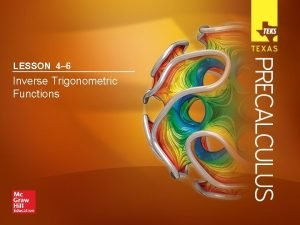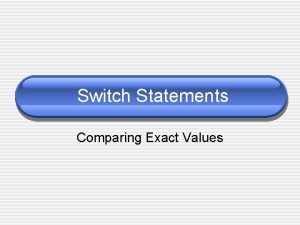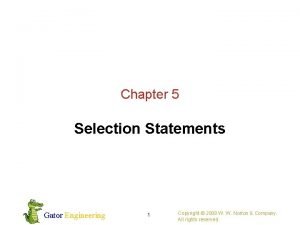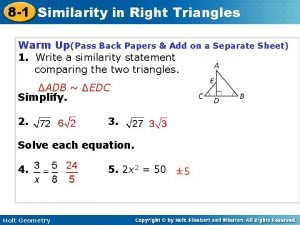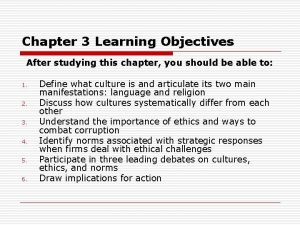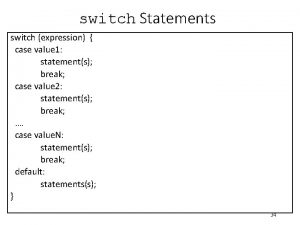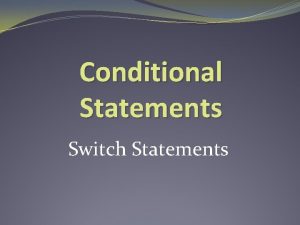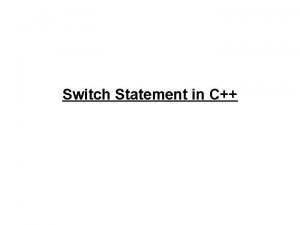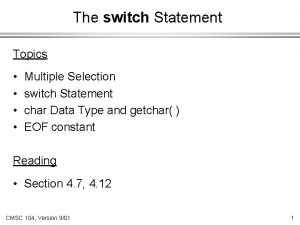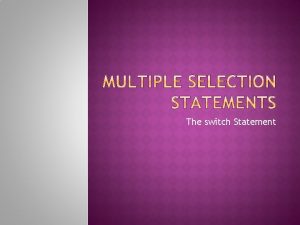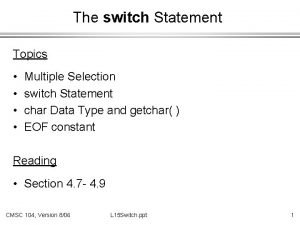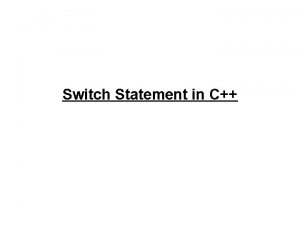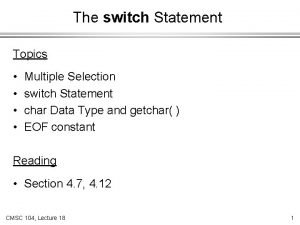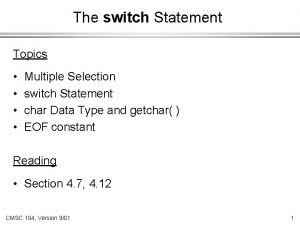Switch Statements Comparing Exact Values The Switch Statement











- Slides: 11

Switch Statements Comparing Exact Values

The Switch Statement • The switch statement provides another way to decide which statement to execute next • The switch statement evaluates an expression, then attempts to match the result to one of several possible cases • The match must be an exact match. switch ( expression ){ case value 1 : statement-list 1 case value 2 : statement-list 2 case value 3 : statement-list 3 case. . . } 2

The Switch Statement • Each case contains a value and a list of statements • The flow of control transfers to statement associated with the first case value that matches switch ( expression ){ case value 1 : statement-list 1 case value 2 : statement-list 2 case value 3 : statement-list 3 case. . . } 3

Switch - syntax • The general syntax of a switch statement is: switch and case are reserved words switch ( expression ){ case value 1 : statement-list 1 case value 2 : statement-list 2 case value 3 : statement-list 3 case. . . } If expression matches value 3, control jumps to here

The Switch Statement • The break statement can be used as the last statement in each case's statement list • A break statement causes control to transfer to the end of the switch statement • If a break statement is not used, the flow of control will continue into the next case switch ( expression ){ case value 1 : statement-list 1 break; case value 2 : statement-list 2 break; case value 3 : statement-list 3 break; case. . . }

Switch Example • Examples of the switch statement: switch (option){ case 'A': a. Count++; break; case 'B': b. Count++; break; case 'C': c. Count++; break; }

Switch – no breaks!!! • Another Example: switch (option){ case 'A': a. Count++; break; case 'B': b. Count++; break; case 'C': c. Count++; break; } switch (option){ case 'A': a. Count++; case 'B': b. Count++; case 'C': c. Count++; }

Switch - default • A switch statement can have an optional default case • The default case has no associated value and simply uses the reserved word default • If the default case is present, control will transfer to it if no other case value matches • If there is no default case, and no other value matches, control falls through to the statement after the switch

The switch Statement • Switch with default case: switch (option){ case 'A': a. Count++; break; case 'B': b. Count++; break; case 'C': c. Count++; break; default: other. Count++; break; }

To Switch or not to Switch • The expression of a switch statement must result in an integral type, meaning an integer (byte, short, int, long) or a char • It cannot be a boolean value or a floating point value (float or double) • The implicit boolean condition in a switch statement is equality • You cannot perform relational checks with a switch statement

Questions? ? To switch or not to switch, that’s the question…. java/Switch. Example. java Switch. Nboolean. java Swithc. Nothers. java
 Higher maths exact values
Higher maths exact values Exact values chart
Exact values chart Trigonometry right angled triangles
Trigonometry right angled triangles Finding exact values of inverse trig functions
Finding exact values of inverse trig functions Higher maths exact values
Higher maths exact values Higher maths vectors
Higher maths vectors A switch combines crossbar switches in several stages
A switch combines crossbar switches in several stages Go switch model 11
Go switch model 11 What are switch statements in c
What are switch statements in c Are switch statements faster than if/else
Are switch statements faster than if/else Write a similarity statement comparing the two triangles.
Write a similarity statement comparing the two triangles. Western vs eastern values
Western vs eastern values



